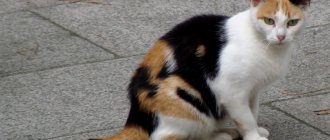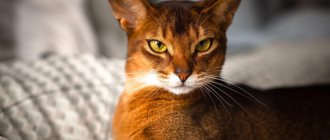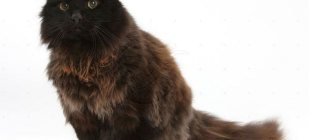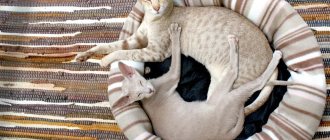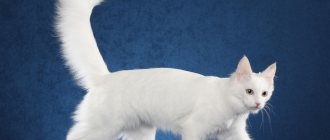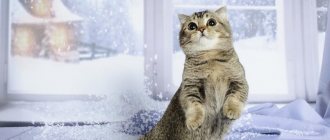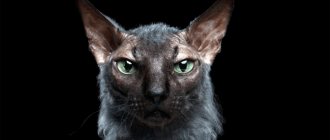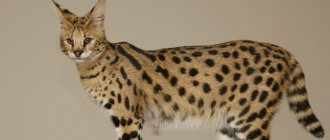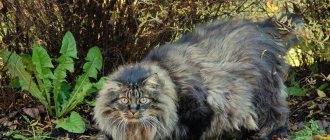Although many legends and traditions associated with cats have been preserved in the national Irish epic, this people never acquired their own breed. This is all due to the defeat of the independence fighters at the end of the 18th century, which ended with annexation to the British crown.
Along with the lands, local domestic animals also came under the rule of the empire. Since then, the term “Irish cat” has ceased to refer to one breed, but has become a collective image that combines several ancient breeds.
History in the chronicles and the actual origin of the Irish cat
10 centuries ago, Welsh laws determined not only the social structure of the territory of Wales, but even such little things as the cost of a domestic cat - 4 pence. At the same time, an age gradation was provided:
- from birth to the moment the eyes open, an Irish kitten cost 1 penny;
- after the first mouse killed, the price increased to 2d;
- As soon as an Irish cat became a full-fledged hunter, it was already valued at the full amount - 4 pence.
The Irish also added a cat to the list of things necessary for every housewife.
If someone's cat was killed by an Englishman, he was obliged to compensate for the damage with a lamb or an adult sheep. Sometimes they paid in grain - a pile of wheat had to cover the entire length of an Irish cat. But the presence of a domestic rat catcher at a housewarming party, unlike Russian tradition, was not allowed.
The patron saint of Irish cats was Saint Patrick himself, but this did not save the local breed from extinction. As soon as power passed to Britain, the history of a separate species ended, and a new page in the cat's pedigree opened.
Description of the British
A century and a half ago, the British Isles were considered the world felinological center. Exotic cats came here along with the military and merchants from the East. It was during this period that the crossing of local animals with those brought on ships from distant countries began.
Thus, the Irish cat breed completely merged with the new English population.
The ancestors of ordinary British cats came to the islands with the Roman conquerors. It is believed that these were representatives of the Egyptian cat breed, but there is no factual evidence of this.
In England, they adapted to new climatic conditions, acquired thick hair and established family relationships with local four-legged rat catchers, among which a branch of Irish cats was already represented.
This is how a group of British cats was formed, which was later recognized as an aboriginal breed with certain external characteristics:
- Stocky animals with a harmonious physique.
- Gray-blue color, traditional for the British breed.
- All the lines of the body and head of the British are smooth - even the tail ends in a slight curve.
- The ears are set wide, forming an equilateral triangle between their bases and the nose.
- Round cheeks.
- Low legs with round, powerful paws.
- The most common eye color is honey-amber, but green, blue and even lavender are also acceptable.
The descendants of Irish cats are distinguished by good health. They often live to an old age (20 years), and do not suffer from chronic diseases.
Plain (solid, solid)
Golden chinchilla cat. description, features, care and price of the breed
The monochrome uniform coloring of Scottish cats is considered classic by breeders. The solid or solid color of the animal implies the absolute exclusion of any inclusions, small marks and specks of a different color. The tone is rich, even along the entire length of the coat.
The most common used to be considered blue plain Scots. But today among the representatives of the breed there are many other variants of solid colors.
White
A Scottish cat with snow-white fur (without yellowness) looks luxurious. Possible eye colors are blue, amber, copper. According to the standard, eyes of different colors are allowed. The paw pads and nose are light pink.
Kittens may have markings of a different shade, which disappear after the first coat change. By the age of two, the coat of a white Scot should be crystal clear, without spots of a different color.
Black
The black cat has expressive yellow eyes. The nose and paw pads practically blend into the main color of the animal.
On the shiny bright coat of the Scottish beauty Ebony, 2-3 hairs of contrasting white color are allowed. The presence of large red or brown marks is not provided for by the standard.
Chocolate
The brown Scottish cat, also called chocolate, looks noble and impressive. The color of the coat contrasts with the animal's yellow, golden or copper eyes. The nose and paw pads are also dark brown.
Lilac (lavender)
The monochromatic lilac Scottish Fold has a gentle gray tint that smoothly turns into cream. The nose is slightly brownish, the paws on the bottom are the same color as the coat, in harmony with the main color of the pet. This lilac-lavender color goes well with eyes of copper, amber or orange shades.
Red (red)
Red or ginger color is a rare and valuable color of the Scots breed. The fiery edge is combined with burning amber irises. Pads and nose to match the dominant color.
The tail of kittens and adult animals is not very evenly colored. This deficiency does not disappear with age and is allowed by the standard. And the presence of marks on the head and limbs that remain after reaching the age of two are considered a deviation from the norm.
A red Scottish straight-eared cat can give birth to kittens not only with erect ears, but also with ears pressed to the head.
Cream
The cream or peach fold cat is infinitely elegant and beautiful. The delicate background of light fur, bright golden eyes and a pinkish nose give the pet an irresistible appearance. The pads on the paws are also pink. An animal with this color is similar to a red Scotsman, but its coat color is a shade lighter.
A peach fold kitten may have a blurry, fuzzy pattern on its paws and tail that does not disappear with age. This is not critical for a purebred pet, but leopard markings are absolutely unacceptable.
Faun (deer)
There is another unique color of Scottish fold cats with an interesting name - fawn, which means “young deer”. The nose and pads on the paws of these beauties are beige-pink.
Cinnamon
Cinnamon is a lighter and more delicate color than chocolate, but darker than red. The nose and paw pads of such animals are brown, beige or pink.
Blue color (blue)
The gray or blue Scottish cat has very beautiful amber eyes. The coat tone of a purebred pet can belong to any range of gray - from the lightest (blue) to completely dark (blue). At the same time, each hair is saturated and well colored, without streaks.
The nose and pads practically do not differ in color from the plain coat.
A gray Scottish Straight cat may be marked with a few streaks and drawings in childhood. But as they grow older, these color flaws go away.
Description of Scottish Fold cats
In 1961, in Scotland, not far from the town of Cupar Angus, an unusual white cat appeared. The only distinguishing feature from the traditional British breed was its ears. Their tips curved forward, which gave the round muzzle an unusual appearance.
Later, Susie's cat gave birth to kittens, two of which inherited an external genetic change. One of them was sterilized, and the second was purchased by farmer William Ross, a big cat lover. Together with geneticist Pat Turner, they developed a new breed of fold-eared animals.
Scientists have found that the mutation was caused by an ordinary dominant gene that does not affect the health of the offspring. Subsequently, all work with the breed was transferred to the USA, where the Scottish Fold breed was crossed with British and American shorthair cats.
Scottish Fold descendants of Irish cats differ from the British breed in the following external characteristics:
- The Scots have smaller heads and cheeks that are not as voluminous as the British;
- the legs are higher and the body is more muscular;
- the tail is longer than that of a British cat.
We are different, but we have a lot in common... or breed standards
All representatives of the Scottish breed, except for differences in the position of the ears and the length of the coat, are built almost identically. These animals are small in size, but have a proportionally built body with well-developed muscles. The paws are round, muscular, well developed, and of medium length. All cats have a compact, round head, which is located on a short, strong neck. All animals, regardless of subspecies, have large, round, wide-set eyes, which makes them look like an owl. The length of the tail varies among the subspecies, but all have a characteristic rounding at the tip caused by a shortened tendon.
The colors of representatives of the Scottish breed are very diverse: from the most ordinary, plain, smoky and tortoiseshell, to the unusual and rare tabby, van, tiki.
Character and temperament of the Irish cat
Representatives of the British breed are independent, do not like to be held and do not suffer from loneliness if the owner is away from home for a long time. All this cat needs is food and water.
Sometimes owners share observations about their Britons and note their extraordinary ability to sleep 20 hours a day. Traditional English cats also tend to show aggression.
The Scots differ from them in temperament and character:
- they are affectionate and sociable;
- take part in games with pleasure;
- get along well with other pets.
Nutrition
An important aspect of caring for Scottish Folds is food. Nutrition should be regular and balanced so that the pet is always strong. The best option is a harmonious diet based on natural ingredients.
You can also choose good bagged food. Experts and nurseries recommend a varied diet that contains both natural ingredients and cat food. You should always remember to drink regularly.
The water in the bowl should be renewed daily, no matter how much you drink. It is normal for adults to eat 2-3 times a day. You should not change the types of food frequently, so as not to get a stomach ache.
It should be remembered that cats are contraindicated from eating foods with a lot of fat, with vinegar and salt, fried foods and containing sugar. Seasonings and hot and cold foods should be avoided.
Good for Scottish Folds:
- lean meat;
- fish;
- milk;
- cottage cheese.
Vegetable ingredients, fresh and boiled, and all sorts of cereals are needed.
It is not advisable to give:
- eggplant;
- tomatoes;
- onion;
- garlic.
Feeding an Irish cat
All English breeds are prone to overeating, especially in the second half of life. Therefore, the owner must strictly control the volume of portions and monitor the pet’s physical activity.
The diet for Irish cats depends on the age of the animal:
- As children, they love natural products, and the owners prepare food for the kids themselves. This is a great way to keep the balance of nutrients normal and adjust the menu as necessary.
- Adult cats are switched to industrial food. Dry granules are available in a wide variety of formulations with effective additions of vitamins and microelements.
- In old age, metabolism decreases, problems with teeth, hair and the musculoskeletal system appear. Therefore, animals are transferred to a combined diet - ready-made food and natural products.
The difficult nature of the British does not manifest itself in their pickiness about food. They have a normal attitude towards all products and do not require any “aristocratic” delights for themselves.
What does the price depend on?
- Pedigree. First of all, the price of any individual (in qualified nurseries) depends on the pedigree. For example, if the kitten’s parents participated in various exhibitions and took places, then their kitten will accordingly cost more than the one whose parents have a less vibrant and voluminous pedigree.
- Floor. A female will be slightly cheaper than a male.
- Purpose. It depends on what purpose you are purchasing the animal for. There are two options: either as a pet, or for exhibitions and further breeding. Then you need to look at what class the cat belongs to (described in more detail in the next paragraph) and look at the prices.
- Age. The point is quite important, since most often grown-up individuals are sold cheaper than kittens (2.5-3 months)
- Color. This is also an important point that affects the cost. Rarer colors tend to be more expensive than common ones.
Chantilly Tiffany cat. description, features, care and price of the breed
Education and physical activity
Features of raising and keeping a cat directly depend on the nature of the breed:
- The British are reluctant to support common games. In childhood, these cats do not devote much time to fun, but with all their appearance they show that they are simply doing a favor to the owner, who wanted to chase a ball of thread.
- Scots remain active throughout their lives.
The process of raising a Briton cannot be interrupted for a minute. Otherwise, this wayward cat will quickly imagine itself as the head of the family and begin to establish its own rules. By the way, the Briton willingly uses both teeth and claws.
The Scottish Fold is the exact opposite of the British cat breed. We can say that his delicacy knows no bounds. He can do something contrary to his beloved owner only in one case - from pain.
What do the Scots get sick of?
Like most animals, Scots tend to get sick, so regular examination by a veterinarian will certainly not harm them. Diseases specific to this breed include joint pathologies. Osteochondrodysplasia is the destruction of articular cartilage, an incurable and irreversible process. At the same time, the animal is limping, its movements are stiff, and movement is difficult.
In addition to joint problems, Scots are prone to obesity, and, as a result, heart problems. Cardiomyopathy, a disease accompanied by heart failure.
In all cases, it is strictly forbidden to self-medicate. The animal must be urgently shown to a specialist who will make a diagnosis and prescribe treatment.
Pros and cons of breeds
Among the English descendants of Irish cats, you can choose a four-legged pet to suit every taste if you carefully study its breed qualities.
| Characteristics | British | Scottish |
| Size | Large | Average |
| Health | Strong | There is a predisposition to certain diseases |
| Lifespan | 15 or more years | 10-15 years |
| Character | Closed, solitary | Communicative |
| Aggressiveness | Average | Low |
| Activity | Low | Average |
| Loyalty to people | Low | High |
| Relationships with other animals | Bad | Excellent |
| Specific dietary requirements | None | None |
| Grooming and other hygiene | Combing, cleansing mucous membranes | Combing, cleansing mucous membranes, ear hygiene |
British cats are great for busy people who spend a lot of time at work and do not have the opportunity to constantly communicate with a cat. In this scenario, the English cat appears in an advantageous light.
But for long family gatherings, general games and joint walks, the Scottish Fold is perfect. There is only one nuance - you need to monitor their games with children so that the kids do not accidentally damage the delicate cat ears.
These are the descendants of ancient Irish cats. In Celtic mythology, many entertaining pages are devoted to these animals. Cats had their own king, and they passed this title on through inheritance. They also blessed any house if the owners left a saucer of milk at the doorstep.
Traditionally, Irish cats were depicted in black color with an elegant white shirtfront on the chest. Similar colors are often found in the modern British breed. It is possible that the legend about the transmigration of cat souls is not such a fantastic invention.
Highland Fold: keeping a purebred cat at home
Grooming.
Many potential owners of Scottish Fold long-haired cats may be seriously intimidated by their fur coat, since it is very difficult to care for. But this is not at all true, despite all the splendor of the fur of these purrs, it does not need any particularly complex and troublesome care. In general, in order for an animal to always look chic, it is enough to comb its coat 3-4 times a week using a medium-hard massage brush. You can also use a rubber glove - the choice is yours. During the molting period, this procedure should be carried out more frequently until daily combing; it is worth noting that pets do not shed very profusely. But when it comes to bathing, the opinions of scientists differ. Some advise washing cats frequently, while others recommend not to overuse this procedure, since a cat’s fur can lose all its splendor from interaction with water and detergents, especially those that are not of the highest quality. It should be noted that representatives of this breed do not have a special love for water, so in order not to stress your furry friend, bathe him when absolutely necessary; if this does not arise, then once every six months will be more than enough. Ear care. Due to the special structure of the auricle of fold-eared cats, caring for them is a little more difficult than for others. These cats also need to have their ears cleaned, but this needs to be done about 2 times a week. This procedure, which is not entirely pleasant for the Highland Fold, must be carried out using special cotton swabs with a limiter; it will prevent injury to the cat’s sensitive eardrum. As an aid, veterinarians advise using a special lotion for cleaning cats’ ears; it can be purchased at any veterinary pharmacy. Many cat owners often neglect this hygiene procedure, considering it not particularly necessary, but this is not so. Earwax, dirt particles and dead epidermis accumulate in large quantities in the external auditory canal of the animal. If all this “good” is not removed, the consequences can be fatal, even to the point that the cat may lose hearing. In addition, such an environment is simply a resort for ear mites, which can cause a disease such as otodecosis. Most often, ticks infect small kittens. The first symptoms of this disease are severe itching and profuse brown discharge. If you notice something similar to a Highland Fold, you should immediately show it to a veterinarian for diagnosis and subsequent treatment.
It is important to know that sometimes ear mites can come out of the ear canal and spread to the cat's body and be transmitted to another pet. Therefore, if you have, for example, a cat and a dog, then it is recommended to show it to a doctor.
These ear mites are not dangerous to humans.
Teeth. These purrs need to brush their teeth in order to prevent the deposition of tartar and the occurrence of inflammatory diseases of the soft tissues of the oral cavity. The optimal frequency of brushing teeth is 2-3 times a week; you can also add special food for cleaning teeth to your cat’s diet.
Eyes should be wiped once a week with a cotton pad soaked in a disinfectant solution.
What to feed? The Highland Fold's diet should be balanced; the best option would be ready-made food, both dry and wet, of good quality. It is best to give preference to premium and super premium food. Additional vitamin complexes will not be superfluous, especially during the molting period.
